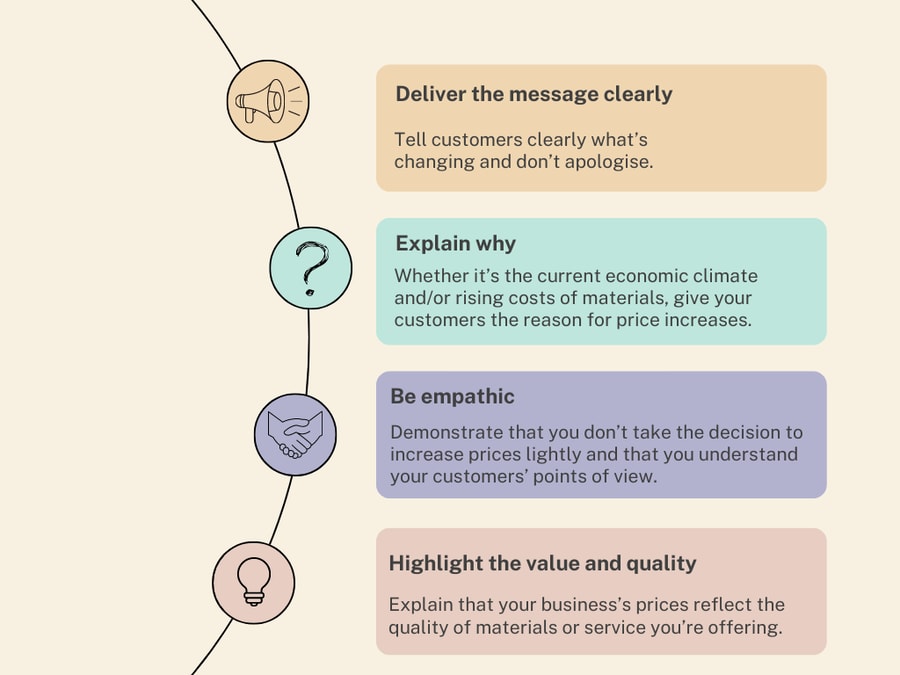The UK recession, global supply chain disruptions, and ever-increasing inflation rates have all added to significant economic uncertainties for businesses and consumers alike. Despite this, as of September 2022, 42% of businesses reported they hadn’t yet passed on these higher costs to their customers.
The Fleximize SME Outlook Report found that 54% of businesses say energy price hikes are a major concern, followed by increasing staff wages (38%) and supply costs (37%).
As a business owner, this increased pressure may lead you to raise prices to recoup some revenue and survive another year. The question is, how do you do this without losing your loyal customers?
When is the right time to increase your prices?
If you’re considering increasing the prices of your products or services, it’s vital to get the timing right to retain business and gauge the impact on your profit margins.
Consider whether you'll implement price increases incrementally, all at once, or in stages. Some business owners even raise prices at the beginning of every year based on increasing overheads.
You may have to be more reactive and increase your prices because of an unexpected cost. For example, the cost of renting your office space may go up, so you're forced to increase your prices sooner rather than later.
Whatever you decide, be sure to communicate with your customers in advance. That way, they can place orders at existing prices or budget for the increase.
5 ways to plan for price increases
1. Itemize everything
Use an inventory accounting system to create a list as part of your pricing strategy. This will help you to itemize all your products with their relevant profit margins.
Identifying your products or services with the highest profit margins means you’ll be able to determine the biggest impact on your profitability. If you offer more price-sensitive options, you may want to stick with those prices if they don’t have much of an impact on your bottom line.
Creating sales-profit projections will allow you to compare and forecast profit based on individual item price changes and avoid making common financial pitfalls.
2. Analyse your offering
Adjusting your prices is also the perfect opportunity to analyse where your business is currently doing well and what needs improving. Things to ask yourself include:
Are your customers satisfied with your current products and services?
Are you receiving positive feedback?
Is your current system holding you back? If so, you may need to invest in a new one.
Which of your products or services are in high demand or often sell out?
In addition, review historical data to determine the impact of previous price increases.
Consider what made you increase prices in the past. Was it down to product changes or wholesale prices increasing? Look at the bigger picture to determine how price increases affected your sales team, customer base, and overall revenue.
While you may have lost previous customers due to price rises, other metrics, such as lifetime value, may have increased. Likewise, how you present your offerings can significantly affect their value and the value of your business.
Doing this research will help to predict how your current customers will react to increasing your business’s prices.
3. Check out the competition
Before you even think about increasing your prices, it’s essential to research what your competitors are doing. The easiest way to do this is by searching for your products or services category on the web.
Once you've identified who your main competitors are have a look at their unique selling points (USPs). How do they compare to yours? Are they selling their products or services at a higher or lower price? If they're cheaper than you, is it because they're using cheaper materials or saving money in an area that you're not able to?
Take a look at their reviews to see if their customers are happy. If you see they're not, write down all the things that they're complaining about to ensure you offering full satisfaction within those areas. This will also help you justify the price increase because you'll be providing value where your competitors are lacking.
All of this analysis will help you define a fair price point for your products or services.
4. Create an effective message
To successfully implement a price increase, it's important that your sales and marketing teams work together to create a message that avoids upsetting your customers. They will need to focus on the value of your products or services and the reasoning behind the price increase. Once this is done, it needs to be projected throughout your entire organisation, so that none of your employees accidentally gives a prospect or customer the wrong price.
It might be helpful for your marketing team to create email templates for your sales and customer service teams to ensure everyone is conveying the same message. We've even listed some useful phrases to include towards the end of the article.
Continue to get feedback from other departments about how the price increase is affecting your customers, so you can develop your messaging and prepare responses for different situations.
5. Track the impact
Ensure you understand the impact increasing your prices will have on your business and customers. Measure how many regular customers you've lost compared to new customers you've gained because of the price increase. Track the sales to gauge the impact on your business's profitability.
Consider which is the best inventory management system to use to monitor key financial figures, including total sales revenue and volume of sales. From there, you'll be able to make data-driven decisions and ensure you're always meeting your customer's expectations whilst maintaining a healthy cash flow.
How do you communicate price increases with your customers?
As you prepare for price increases, the main thing to remember is to be transparent with your customers – they will appreciate your honesty. Here are some ways to handle communicating your business’s price increases:

Useful phrases
Consider these phrases when communicating price increases with your customers:
“This price change helps us ensure our commitment to providing the very best products and services to you.”
“Please be assured that we have made every effort to keep this price increase to a minimum and will continue to honour current price structures up to <insert date>.”
“As always, we are committed to providing quality products and services and appreciate your business and continued support.”
“If you have any questions or concerns, please do not hesitate to reach out. Our team is more than happy to discuss this with you, as your satisfaction is our priority.”
Ready, set, increase
Before implementing a price increase strategy, ensure you’ve planned ahead and considered your current costs and any cost increases you anticipate in the next year or two to support sustainable growth.
Clear communication with your customers is essential whether you are raising prices because your own costs are increasing or spending more on improving products. Any price increase may come as a shock to your customers, so you need to be prepared to deal with their response.
That said, if you carefully plan your pricing strategy, clearly communicate with customers, and continue providing valuable products and services, it should offer an opportunity for growth.
About the author
Nick Shaw has been the Chief Revenue Officer (CRO) of Brightpearl, the number one retail-focused digital operations platform and stock monitoring software, since July 2019 and is responsible for EMEA Sales, Global Marketing and Alliances.









These cookies are set by a range of social media services that we have added to the site to enable you to share our content with your friends and networks. They are capable of tracking your browser across other sites and building up a profile of your interests. This may impact the content and messages you see on other websites you visit.
If you do not allow these cookies you may not be able to use or see these sharing tools.